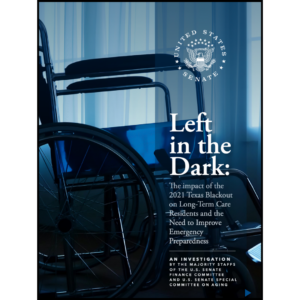Planning for protection
The 9-11-2001 terrorist attacks, the massive disruption that followed Hurricane Katrina, the recurring Midwest floods, and the devastation caused by Hurricanes Gustav and Ike this year all underscore how vulnerable nursing homes and other long-term care facilities are to disasters. Katrina, in particular, showed that widespread failure of support systems and services can have profound effects on those who most need care, on those who care for them, and on the facilities where patients and providers reside and work.
The one piece of good news from such devastating wake-up calls is that in the past few years, facilities across the country have significantly strengthened their emergency planning and staff training. A 2006 survey of Medicare- and Medicaid-certified nursing home facilities conducted by Department of Health and Human Services (HHS) Office of Inspector General, Nursing Home Emergency Preparedness and Response During Recent Hurricanes, (https://oig.hhs.gov/oei/reports/oei-06-06-00020.pdf) found that more than 94% met federal standards for emergency plans, and that a solid 80% are offering sufficient emergency training for their staff.
The bad news is that the impact of a large-scale emergency is felt well beyond the walls of any single institution. To ensure the safety and security of residents and staff, and the long-term viability of buildings and systems, nursing homes and other long-term care facilities must become an integral part of more widespread emergency and disaster planning. That means actively participating in the development and testing of community-wide plans and becoming involved in state and national levels of preparedness, as well.
| Click here to view Ten steps to better preparedness |
Is this happening? It is to a degree, but not nearly enough. The 2006 HHS/OIG survey found that nursing homes are “often not included in community emergency planning.” Yet these facilities play a vital and trusted role, providing care to a community’s most frail and vulnerable populations. At the national level, plans for protecting the nation’s critical infrastructure and key resources from disaster and terrorist attack are being geared to address the risk landscapes of 18 sectors, including a sector focused entirely on the unique requirements of Healthcare and Public Health. In this context, critical infrastructure is defined as assets, systems, or networks that are so vital to this country that their loss or destruction would have a debilitating effect on national security, national economic security, or public health. The Healthcare and Public Health sector comprises the systems, networks, services, goods, facilities, functions, and roles needed to prevent disease and disability, treat patients, foster public health, and respond to emergencies.
A partnership model for planning
At the national level, the Department of Homeland Security, in collaboration with government and private-sector partners, has led an intensive effort to develop the National Infrastructure Protection Plan (NIPP), and more detailed sector-specific plans, including the Healthcare and Public Health Sector Specific Plan. The plans are now being implemented through collaboration between government and private-sector partners that has not been seen since World War II. HHS, as the Sector Specific Agency for the Healthcare and Public Health Sector, worked in collaboration with a council of private-sector organizations representing suppliers and providers of medical and healthcare systems, products, and services, in the recent development and implementation of the plan.
The NIPP is aimed at building a safer, more secure, and more resilient America by enhancing protection of critical infrastructure and key resources. A key dimension of this effort is the strengthening of national preparedness, timely response, and rapid recovery in the event of an attack, natural disaster, or other emergency.
This goal can only be accomplished through a partnership approach. Working together, members of the public and private sectors are able to set goals, prioritize needs, implement programs, and measure the effectiveness of their efforts in an integrated way, basing their decisions on a realistic identification of the assets in place and the risks they face. Clearly, the providers of nursing home and long-term care services bring a key perspective to the process. The facilities themselves are an important component of the nation’s critical infrastructure, and their services are essential to the well-being of many elderly and/or disabled Americans.
Those wishing to learn more about the national planning process and the ways that private-sector partners can engage with it are urged to do so by visiting the NIPP Web site at www.dhs.gov/nipp.
The idea that effective planning requires a full range of partners at the table is just as true locally as it is at the national level. Are nursing homes expecting assistance from the community that local government isn’t prepared to offer? Has the role of suppliers—of medical supplies, oxygen, linens, medicine, etc.—been fully articulated and agreed to? Are adequate contingency approaches in place in case electricity, computers, heat, or other resources are out of commission? Does the evacuation plan take into account that the selected vendor may be unable to reach the facility? Do the community and the nursing home have a common understanding of the plans that are in place?
Related Articles
Topics: Articles , Facility management , Operations











